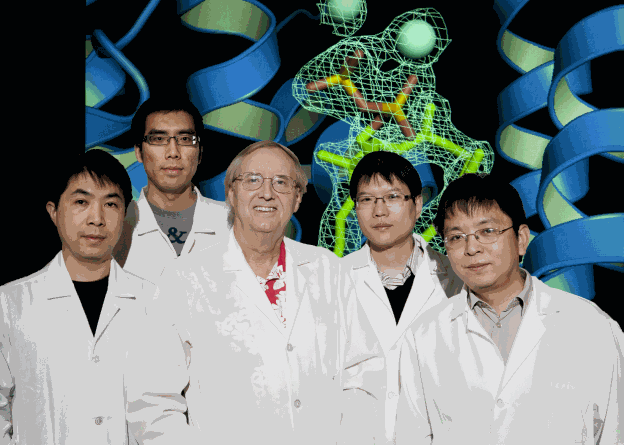Researchers have determined the structure and mechanism of an enzyme that performs the crucial first step in the formation of cholesterol and is a key virulence factor in staph bacteria. The chemists at the University of Illinois (U. of I.) and their collaborators in Taiwan utilized a high-energy x-ray beamline at the Advanced Photon Source at Argonne National Laboratory to study a type of enzyme—found in humans, plants, fungi, parasites, and many bacteria—that begins the synthesis of triterpenes, one of the most abundant and ancient classes of molecules. Triterpenes are precursors to steroids such as cholesterol. Their results were published in the Proceedings of the National Academy of Sciences of the United States of America.
“These enzymes are important drug targets,” said U. of I. chemistry professor Eric Oldfield, who co-led the study. “Blocking their activity can lead to new cholesterol-lowering drugs, antibiotics that cure staph infections, and drugs that target the parasites that cause tropical maladies such as Chagas’ disease, which is a leading cause of sudden death in Latin America.”
For the study, the team picked a representative enzyme, dehydrosqualene synthase (CrtM), from the Staphylococcus aureus bacterium. Staph is one of the most common, yet notoriously hard to kill, bacterial infections. A key reason for staph’s resilience is a golden-colored coating called staphyloxanthin that protects it from the body’s immune system. CrtM catalyzes the first reaction in making staphyloxanthin, so inhibiting it would strip the bacteria of their protective coats and leave them vulnerable to attack by white blood cells.
The researchers already knew what CrtM looked like and its end product, but they didn’t know how the enzyme did its job. Uncovering the mechanism of that action would enable scientists to design better inhibitors, and even tailor them to other targets.
The team crystallized the enzyme and soaked it with intermediates and inhibitors. They then studied the complex structures by applying the x-ray crystallography technique at the Life Sciences Collaborative Access Team 21-ID beamline at the U.S. Department of Energy Office of Science’s Advanced Photon Source.
The researchers found that CrtM performs a two-step reaction, individually removing two diphosphate groups from the substrate. The substrate switches between two active sites within the enzyme as the reaction progresses. The most effective inhibitors bind to both sites, blocking the enzyme from any action.
“The leads that people have been developing for treating these diseases really haven’t had any structural basis,” said Oldfield. “But now that we can see how the protein works, we’re in a much better position to design molecules that will be much more effective against staph infections and parasitic diseases, and potentially, in cholesterol-lowering.”
The researchers’ inhibitor technologies have been licensed to AuricX Pharmaceuticals, which recently received a grant from the Texas Emerging Technology Fund for preclinical testing in staph infections.
See: Fu-Yang Lin1, Chia-I Liu2,3, Yi-Liang Liu1, Yonghui Zhang1, Ke Wang1, Wen-Yih Jeng3, Tzu-Ping Ko3, Rong Cao1, Andrew H.-J. Wang2,3,*, and Eric Oldfield1**, “Mechanism of action and inhibition of dehydrosqualene synthase,” Proc. Nat. Acad. Sci. U.S.A. 107(50), 21337 (December 14, 2010). DOI: 10.1073/pnas.1010907107
Author affiliations: 1University of Illinois at Urbana-Champaign, 2National Taiwan University, 3Academia Sinica
Correspondence: **[email protected] or *[email protected]
The original University of Illinois at Urbana-Champaign press release can be found here.
This work was supported by grants from the United States Public Health Service [National Institutes of Health Grant AI-074233 (to E.O.)] and from the Academia Sinica and the National Science Council [NSC 97-3112-B-001-017 and NSC 98-3112-B-001-024 (to A.H.-J.W.)]. Portions of the research were carried out at the National Synchrotron Radiation Research Center, a national user facility supported by the NSC of Taiwan, Republic of China, and the Photon Factory in Japan. Use of the Life Science Collaborative Access Team was supported by the Michigan Economic Development Corporation and the Michigan Technology Tri-Corridor for the support of this research program (Grant 085P1000817). Data for the hSQS study were measured at beamline X29A of the National Synchrotron Light Source, where financial support comes principally from the Offices of Biological and Environmental Research and of Basic Energy Sciences of the U.S. Department of Energy, and from the National Center for Research Resources of the National Institutes of Health.
Use of the Advanced Photon Source, an Office of Science User Facility operated for the U.S. DOE Office of Science by Argonne National Laboratory, was supported by the U.S. DOE under Contract No. DE-AC02-06CH11357.
The Advanced Photon Source at Argonne National Laboratory is one of five national synchrotron radiation light sources supported by the U.S. Department of Energy’s Office of Science, Office of Basic Energy Sciences (DOE-BES). The APS is the source of the Western Hemisphere’s brightest high-energy x-ray beams for research in virtually every scientific discipline. More than 3,500 scientists representing universities, industry, and academic institutions from every U.S. state and several foreign nations visit the APS each year to carry out applied and basic research in support of the BES mission to understand, predict, and ultimately control matter and energy at the electronic, atomic, and molecular levels in order to provide the foundations for new energy technologies and to support DOE missions in energy, environment, and national security. To learn more about the Office of Basic Energy Sciences and its x-ray user facilities.
Argonne National Laboratory seeks solutions to pressing national problems in science and technology. The nation's first national laboratory, Argonne conducts leading-edge basic and applied scientific research in virtually every scientific discipline. Argonne researchers work closely with researchers from hundreds of companies, universities, and federal, state and municipal agencies to help them solve their specific problems, advance America's scientific leadership and prepare the nation for a better future. With employees from more than 60 nations, Argonne is managed by UChicago Argonne, LLC for the U.S. Department of Energy's Office of Science.

